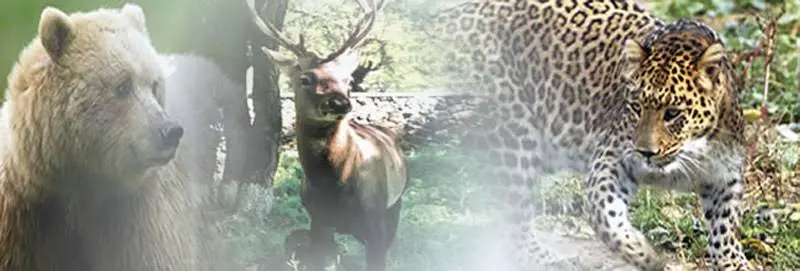Kashmir, often referred to as “Paradise on Earth,” is not only known for its breathtaking landscapes, pristine lakes, and snow-capped mountains but also for its rich and diverse wildlife. Nestled in the northernmost part of India, this region is home to a wide range of flora and fauna, many of which are unique to this part of the world. The varied climate, ranging from temperate to alpine, and the diverse topography, including dense forests, meadows, and high-altitude regions, make Kashmir a haven for wildlife enthusiasts and nature lovers.
The biodiversity of Kashmir is classified into different zones based on altitude and climate, which supports a variety of plant and animal species.The lush greenery of Kashmir is a result of its temperate and alpine forests, which consist of a variety of trees, shrubs, and flowering plants. Some prominent plant species found in Kashmir are:
The lower elevations of Kashmir are covered with dense coniferous forests, primarily consisting of pine, cedar, spruce, and fir trees.Trees like chinar, walnut, and willow add to the beauty of Kashmir, especially during autumn.Above the tree line, lush meadows are home to a variety of flowering plants, including wild tulips, irises, and blue poppies.Many rare medicinal plants like kuth and shilajit are found in the high-altitude regions of Kashmir.
Kashmir is home to some of the most exotic and endangered species of wildlife. The diverse habitats in the region provide a safe environment for a variety of mammals, birds, and reptiles.The Hangul is an endangered species of red deer found only in Kashmir. It is the state animal of Jammu and Kashmir and primarily inhabits the dense forests of Dachigam National Park.
One of the most elusive predators, the snow leopard roams the high-altitude mountains of Kashmir. Its thick fur and strong limbs make it well-adapted to the cold environment.This bear is commonly found in the forests of Kashmir, often venturing near human settlements in search of food.
Found in the high-altitude regions of Ladakh and Kashmir, the brown bear is a rare sight.This small, solitary deer is known for the musk gland in males, which is used in perfumes and medicines. This magnificent wild goat, with its distinctive twisted horns, is one of the rarest species in Kashmir. It inhabits the rugged mountain slopes. The ibex is another high-altitude wild goat found in the rocky terrain of Ladakh and Kashmir.Kashmir is a paradise for bird watchers, as it hosts numerous resident and migratory bird species. Some notable birds found in the region include:This rare and beautiful bird is primarily found in the high-altitude wetlands of Ladakh.Also known as the “national bird of Nepal,” the Monal is known for its colorful plumage.A highly endangered pheasant species found in the dense forests of Kashmir.This majestic raptor soars high above the mountains, preying on smaller mammals and birds.These birds migrate from Central Asia and Tibet to the wetlands of Kashmir during winter.
Located about 22 km from Srinagar, Dachigam National Park is one of the most important protected areas in Kashmir. It is famous for the Hangul deer, which is found exclusively in this region. The Park also houses leopards, Himalayan black bears, and numerous bird species.Situated in Ladakh, Hemis National Park is the largest national park in India. It is a crucial habitat for the elusive snow leopard and other high-altitude species like the blue sheep, ibex, and Himalayan wolf.Located in the Pahalgam region, this sanctuary is home to species like the musk deer, markhor, and black bear. It also serves as an important bird-watching site.This wetland near Srinagar is a crucial habitat for migratory birds, including flamingos, geese, and swans. It serves as a wintering ground for thousands of birds from Siberia and Central Asia.
This reserve is known for its rich biodiversity, including Hangul, black bear, and numerous bird species. It is also famous for its scenic beauty.The diverse wildlife of Kashmir is a testament to the region’s rich natural heritage. From the majestic Hangul deer and elusive snow leopard to the vibrant Himalayan Monal and rare black-necked crane. Kashmir is home to some of the world’s most fascinating species. However, rapid urbanization, habitat destruction, and climate change pose significant threats to this fragile ecosystem. To ensure the survival of these incredible species, there is an urgent need for stronger conservation efforts, community participation, and sustainable development practices. By protecting the wildlife of Kashmir, we not only preserve the region’s ecological balance but also maintain the natural beauty that makes it truly the “Paradise on Earth.”


